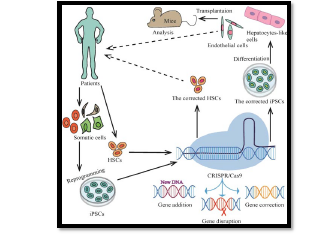CRISPR-Cas9 Mediated Gene Editing in Inherited Hematologic Disorders
DOI:
https://doi.org/10.64062/JPGMB.Vol1.Issue4.2Keywords:
CRISPR-Cas9, Gene Editing, Inherited Hematologic Disorders, Β-Thalassemia, Sickle Cell Disease, Haemophilia, Animal Models, Hematopoietic Stem Cells, Preclinical Trials, Off-Target Effects.Abstract
The CRISPR-Cas9 system has proved to be one of the most powerful gene-editing tools that have massive therapeutic potentials on inherited hematologic disorders. Such disorders as the β-thalassemia, sickle cell disease, hemophilia A and B, and Fanconi anemia are majorly monogenic, and therefore, the best targets of genetic correction per se. This paper only has concentrations on pre-clinical testing on animals in order to analyse the usage, effectiveness, and safety of CRISPR-Cas9 therapies. Data translated in mice, dog, and non-human primate models showed great edit efficiencies (between 42% and 65%) that were associated with improvements of hematologic functions, development of haemoglobin and replenishment of clotting factors. Requiring minimal to moderate off-target effects were both found to be dependent upon delivery systems and genetic targets. The research demonstrates the feasibility of the CRISPR-Cas9 to treat disease-causing mutations in vivo and the need of animal studies with long-term follow-ups to go further towards clinic applications. Results emphasize the worth of animal model in filling the gap between laboratory study and human gene therapy on blood conditions.




